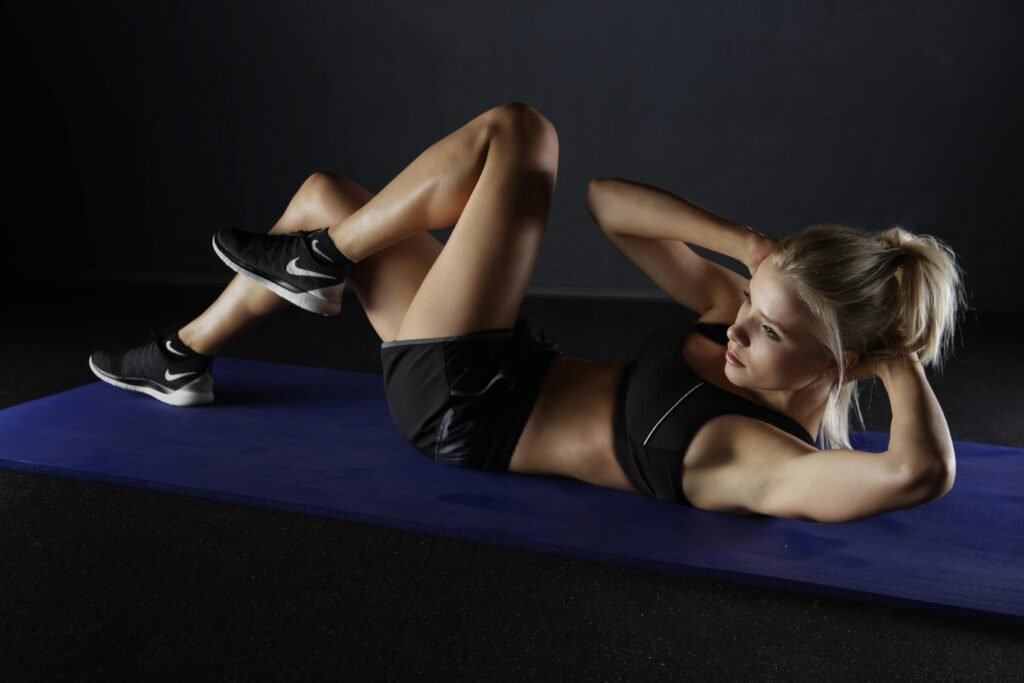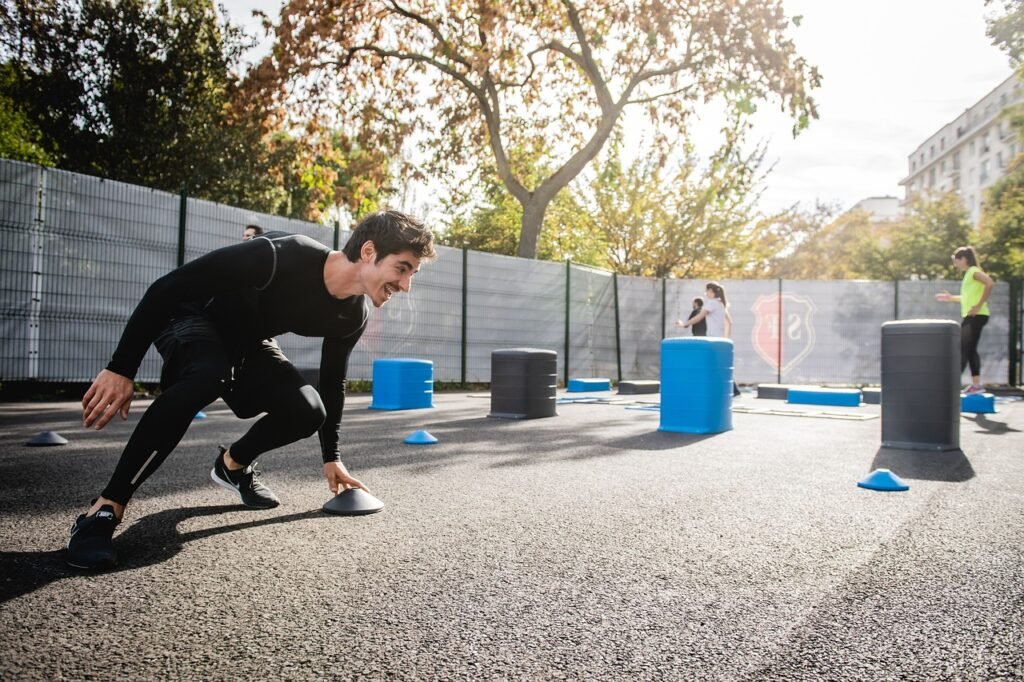
Are you an avid fitness enthusiast looking to buy used exercise gear? Before you lace up those sneakers or grip those weights, it is crucial to ensure that your equipment is clean and sanitized. In this article, we will guide you on the proper techniques to clean and sanitize used exercise gear, helping you to maintain a safe and hygienic workout environment. From yoga mats to resistance bands, we’ve got you covered with easy-to-follow tips that will keep your gear in top-notch condition. So, let’s get started and make your fitness journey not only enjoyable but also clean and germ-free!

This image is property of images.pexels.com.
Gather Necessary Cleaning Supplies
Before you begin cleaning your used exercise gear, it’s important to gather all the necessary cleaning supplies. Having everything ready will make the process smoother and more efficient. Here are the supplies you will need:
Gloves
To protect your hands from any chemicals or dirt, it’s essential to wear gloves during the cleaning process. Choose gloves that are comfortable and fit well, allowing you to move your fingers freely.
Microfiber cloths
Microfiber cloths are excellent for cleaning various surfaces without leaving behind lint or scratches. These cloths are highly absorbent and can remove dirt and grime effectively.
Cleaning solution
Select a cleaning solution suitable for the materials of your exercise gear. For fabric and textiles, consider a mild laundry detergent, while for hard surfaces, a multipurpose cleaner is often sufficient. Alternatively, you can make your own cleaning solution using water and vinegar.
Spray bottle
A spray bottle will come in handy when applying the cleaning solution to your gear. It allows you to distribute the solution evenly and control the amount used.
Scrub brush
A scrub brush with soft bristles will be useful for removing tough stains or dirt on hard surfaces or non-washable gear. Ensure the brush is appropriate for the surface you are cleaning to avoid causing any damage.
Vacuum cleaner
If your exercise gear includes items such as yoga mats or upholstery that cannot be machine washed, a vacuum cleaner with a suitable attachment can help remove dirt, dust, and debris.
Sort and Separate the Gear
The first step in cleaning your used exercise gear is to sort and separate it. This process helps you categorize your items and determine the best cleaning methods based on the item’s material and level of dirtiness.
Separate washable and non-washable items
Begin by separating your gear into washable and non-washable categories. This will help you decide which items can be cleaned in a washing machine or by hand and which ones require alternative cleaning methods.
Organize items based on material type
Next, organize your gear based on the material type. For example, group together all your fabric and textile items, such as gym clothes, towels, and yoga mats. This way, you can tailor your cleaning approach and ensure you’re using the appropriate cleaning solutions and techniques for each material.
Sort by level of dirtiness
Lastly, sort your gear based on the level of dirtiness. Identify items that require more attention due to visible stains or odors. By prioritizing these heavily soiled items, you can pre-treat them and ensure a thorough clean.

This image is property of images.pexels.com.
Pre-Treat Stains and Odors
To tackle any stubborn stains or lingering odors on your exercise gear, it’s essential to pre-treat them before cleaning. Following these steps will help ensure the best results:
Identify specific stains and odors
Carefully inspect each item for any specific stains or odors. Doing so will help you choose the appropriate stain removers and odor-neutralizing products to effectively eliminate them.
Apply appropriate stain removers
Once you’ve identified the stains, apply the appropriate stain removers to the affected areas. There are various stain removal products available, such as enzyme-based cleaners for protein stains (sweat, blood, or food) or specific solutions for oil-based stains (grease or makeup).
Allow time for pre-treatment to work
After applying the stain removers, it’s crucial to allow sufficient time for the pre-treatment to work. Follow the instructions on the product labels and give the cleaners time to dissolve and lift the stains effectively. Patience is key to achieving the best results.
Clean Fabric and Textile Items
Fabric and textile items, such as gym clothes, towels, and yoga mats, require special attention when cleaning. Here are some guidelines to follow:
Read care labels for specific instructions
Before cleaning any fabric or textile gear, always refer to the care labels attached to the items. These labels provide specific instructions on the recommended cleaning methods, including water temperature, washing machine settings, and whether hand-washing is necessary.
Machine wash or hand wash when appropriate
If the care labels allow for machine washing, place the items in the washing machine according to the instructions. Be sure to separate light and dark colors to prevent color bleeding. For delicate items, consider hand-washing them in a sink or basin using gentle detergent and lukewarm water.
Use appropriate temperature and detergent
Choose the appropriate water temperature and detergent for the items being cleaned. Hot or warm water is often suitable for removing sweat and bacteria effectively. Additionally, select a mild laundry detergent that is free from harsh chemicals or additives to protect the integrity of the fabrics.
Dry completely before use or storage
Once the fabric and textile items have been cleaned, ensure they are completely dry before using or storing them. Hang them in a well-ventilated area or use a tumble dryer on low heat, following the care label instructions. Properly drying your gear prevents the growth of mold, mildew, and unpleasant odors.

This image is property of images.pexels.com.
Clean Hard and Non-Porous Surfaces
For exercise gear with hard and non-porous surfaces, such as dumbbells, weight benches, or exercise machines, follow these steps to ensure a thorough clean:
Use disinfectant wipes or solution
To effectively sanitize hard surfaces, wipe them down with disinfectant wipes or a cleaning solution appropriate for the material. Disinfectant wipes are convenient for quick cleanings, while a solution can be applied using a microfiber cloth or spray bottle.
Wipe down surfaces thoroughly
When cleaning hard surfaces, make sure to wipe them down thoroughly, paying attention to all areas that come into contact with your skin or sweat. This includes handles, grips, buttons, and any other high-touch areas that can harbor bacteria or germs.
Pay attention to high-touch areas
Certain exercise equipment may have specific high-touch areas that require extra attention. For example, a treadmill’s console, a spin bike’s handlebars, or weightlifting equipment’s gripping surfaces. Clean these areas more frequently to minimize the spread of germs and bacteria during your workouts.
Allow sufficient contact time for disinfecting
To ensure effective disinfection, it’s crucial to follow the instructions on your chosen cleaning solution or disinfectant wipes. Some products require a specific contact time to kill bacteria and viruses effectively. Be patient and allow sufficient time for the disinfectant to work its magic.
Disassemble and Deep Clean Equipment
For exercise gear that can be disassembled, such as weightlifting benches, yoga props, or resistance bands, it’s essential to deep clean each component individually. Follow these steps for a thorough clean:
Refer to user manuals for disassembly instructions
Before disassembling any equipment, consult the user manuals or instructions provided by the manufacturer. These resources will guide you on the proper disassembly process and help ensure that you can safely reassemble the gear afterward.
Clean each component separately
Once you’ve disassembled the equipment, clean each component individually. This allows for a more thorough clean by reaching hidden areas or crevices where dirt or sweat may accumulate. Use the appropriate cleaning tools, such as brushes or cloths, for different parts to avoid damaging the surfaces.
Use appropriate cleaning tools for different parts
When cleaning different components, utilize the appropriate cleaning tools based on the material. For example, use a soft cloth or brush for wooden surfaces and a mild detergent or wood cleaner specifically formulated for cleaning wood. Pay attention to any specific instructions provided by the manufacturer.
Check for hidden dirt or debris
As you clean each component, be thorough and check for any hidden dirt, dust, or debris. Removing any substances that may have accumulated in hard-to-reach areas will help maintain the integrity of your equipment and prolong its lifespan.
Remove Lingering Odors
Over time, exercise gear can develop lingering odors. Follow these steps to freshen up your gear and eliminate any unpleasant smells:
Place gear in well-ventilated area
Start by placing your gear in a well-ventilated area, such as near an open window or in a breezy spot outdoors. This will help air out the gear and reduce any trapped odors.
Use odor-neutralizing products or sprays
Consider using odor-neutralizing products or sprays specifically designed to eliminate odors on fabric and textiles. These products work by neutralizing the odor molecules instead of simply masking them, leaving your gear smelling fresh and clean.
Consider using baking soda as a natural deodorizer
Baking soda is a versatile and natural deodorizer that can be used on various surfaces. Sprinkle baking soda onto your gear, allowing it to sit for a few hours or overnight. Then, simply vacuum or wipe away the baking soda residue.
Allow gear to air out before storage
Before storing your gear, ensure it has had sufficient time to air out completely. This will help prevent any moisture buildup and the development of musty odors. Open windows, turn on fans, or use a dehumidifier in the storage area to promote air circulation.
Sanitize and Disinfect
Proper sanitization and disinfection are crucial for maintaining a clean and safe exercise environment. Follow these steps to effectively sanitize and disinfect your gear:
Choose suitable sanitizer or disinfectant
Select a sanitizer or disinfectant that is appropriate for the specific gear and surfaces you are cleaning. Look for products that are effective against a wide range of bacteria and viruses, including those that cause illnesses.
Follow instructions for proper usage
Carefully read and follow the instructions provided by the manufacturer of the sanitizer or disinfectant. Pay attention to recommended contact times and any safety precautions, such as wearing gloves or ensuring proper ventilation during use.
Target high-risk surfaces and areas
When sanitizing and disinfecting your gear, focus on high-risk surfaces and areas that come into frequent contact with your skin. Examples include exercise machine handles, barbells, or yoga mat surfaces. By targeting these areas, you can minimize the risk of germ transmission during your workouts.
Focus on shared equipment and contact points
If you are using shared exercise equipment, such as in a gym or fitness facility, it’s essential to pay extra attention to sanitizing and disinfecting these items. Clean shared equipment thoroughly before and after each use, with a focus on contact points such as handles, grips, or touchscreens.
Proper Storage and Organization
Properly storing and organizing your exercise gear is essential for maintaining its cleanliness and longevity. Follow these tips for effective storage and organization:
Ensure gear is completely dry
Before storing any gear, make sure it is completely dry. Moisture can lead to mold growth, unpleasant odors, and damage to the materials. Air dry items thoroughly or wipe them down with a clean, dry cloth before storing them.
Store in a clean and dry environment
Choose a storage area that is clean, dry, and free from excessive humidity. Avoid locations that are prone to temperature fluctuations or direct sunlight as these can potentially damage your gear. If possible, consider using storage containers or bags to provide an extra layer of protection against dust and dirt.
Use storage containers or bags
To keep your exercise gear organized and protected, consider using storage containers or bags. These can help prevent dust, dirt, or pests from coming into contact with your gear while stored. Label the containers or bags to easily identify and access specific items when needed.
Separate clean and dirty gear
To avoid cross-contamination, separate clean and dirty gear during storage. Designate specific areas or containers for freshly cleaned items, ensuring they are separate from gear that requires cleaning. This practice helps maintain hygiene and streamlines your cleaning routine.
Regular Maintenance and Cleaning Schedule
Establishing a routine for regular maintenance and cleaning of your exercise gear is essential for keeping it in optimal condition. Follow these guidelines for a consistent cleaning schedule:
Establish a routine for regular cleaning
Set a regular cleaning schedule based on your gear usage and personal preferences. Depending on the frequency of use, weekly or monthly cleaning routines may be sufficient. Consistency is key to prevent dirt buildup and ensure a clean and hygienic workout environment.
Set reminders or create a cleaning calendar
To help you stay on top of your cleaning schedule, set reminders or create a cleaning calendar. This can be done using calendar apps, task management tools, or even physical reminders like sticky notes. By creating a visual cue, you’ll be more likely to stick to your cleaning routine.
Inspect gear for damages or wear
During your regular cleaning sessions, take the time to inspect your gear for any damages or signs of wear. Look for frayed edges, loose seams, or any other visible issues that may compromise the gear’s functionality or safety. Address these concerns promptly to prevent further damage.
Replace worn-out or damaged items
If you notice any gear that is beyond repair, worn-out, or severely damaged, it may be time to replace it. Continuing to use compromised gear can pose risks during your workouts and potentially lead to injuries. Invest in high-quality replacements to ensure your safety and enjoyment while exercising.
Cleaning and sanitizing used exercise gear is essential for maintaining a healthy and enjoyable workout environment. By following these comprehensive guidelines and incorporating regular cleaning into your routine, you can keep your gear in excellent condition and ensure a safe and hygienic exercise experience. Remember, a clean workout is a happy and healthier workout!


